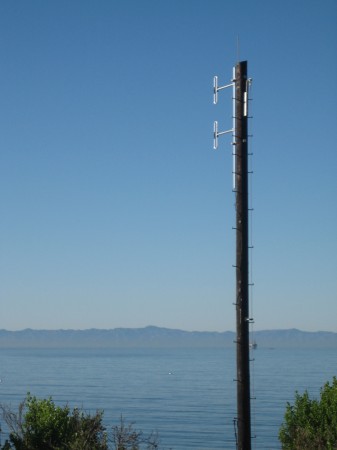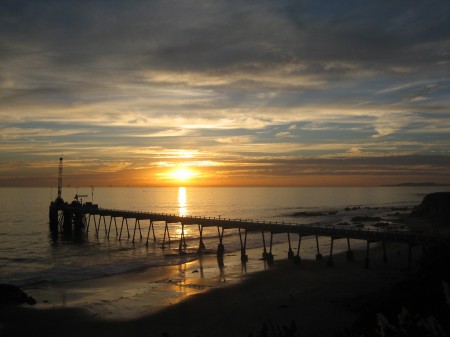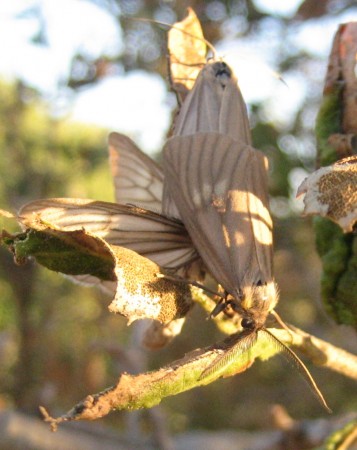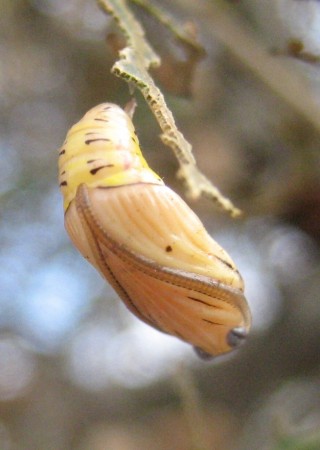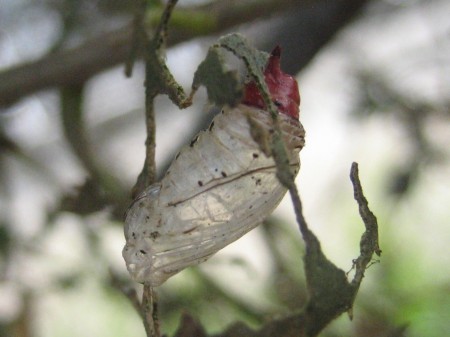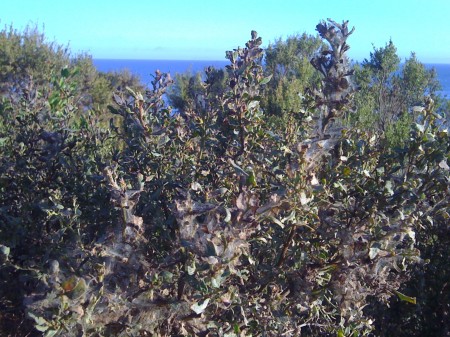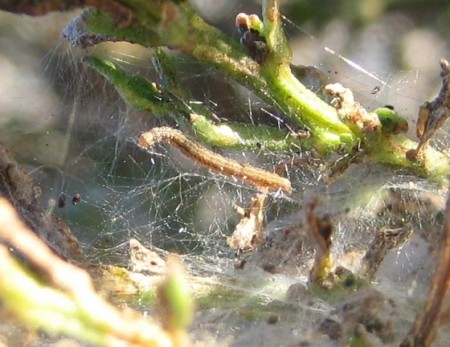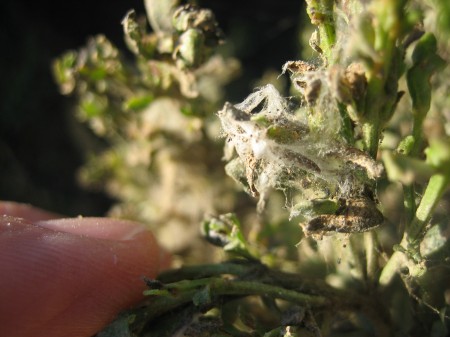I went back to the Bluffs last weekend, checking out the invertebrates in and around the coyote brush (Baccharis pilularis). There was a big fundraiser walk (the Avon Walk for Breast Cancer) going on at the time, so instead of checking the coyote brush up near the Lois Sidenberg overlook, I avoided the crowd by wandering into Mishopshno Meadow, north of the Artists’ Passage.
The first thing I noticed was this fly:

The helpful dipterid experts at Bugguide were quick to ID this as a sinuous bee fly (Hemipenthes sinuosa), a widespread North American species. The “sinuous” in the name refers to the wavy border between the black area at the front of the wing and the clear area at the back of the wing. The fact that there is a rounded black “meatball” along that border near the tip of each wing is what tells us this is H. sinuosa; other members of the genus have a more jagged border. According to Wikipedia, Hemipenthes larvae are hyperparasites on parasitic Hymenoptera (bees, wasps, and allies).
Not far from where I photographed the sinuous bee fly, I noticed a web with a cool-looking stabilimentum of trash running down the middle, and took this photo:

Silly me. I didn’t even notice what was sitting at the center of the web until I got home and looked at the images on my computer. Here’s a closer view:
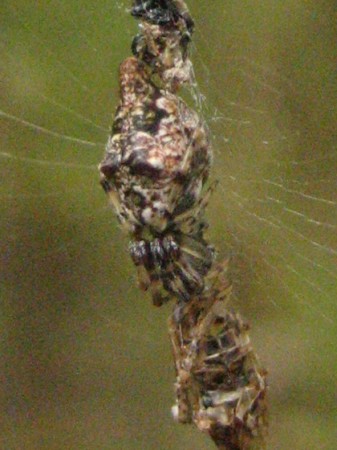
That’s a female trashline orb weaver spider (Cyclosa turbinata). She spins a fresh web each night, using the debris from the old web (and the body parts of her prey) to build the stabilimentum, which she then uses as camouflage — highly effective camouflage, judging from my experience.
I photographed a second trashline orb weaver female, again without realizing it, a few minutes later:
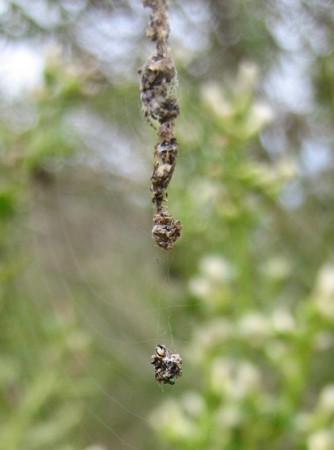
Here’s the (slightly fuzzy) closeup. Again, she’s perched right at the center of the web, which I assume lets her respond quickly when she detects vibrations:
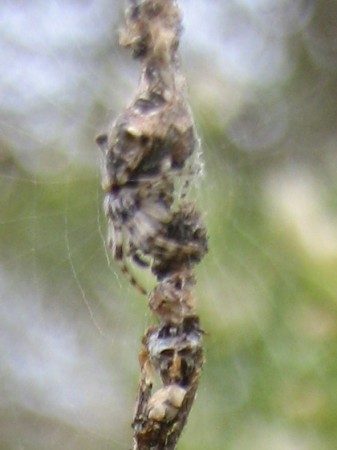
In both closeups you can see the two raised bumps on the dorsal side of the spider’s abdomen, near the front. Those bumps were cited by my helper on Bugguide as cementing the ID as C. turbinata.
I had fun examining the newly emerging flowers on the coyote brush. Coyote brush is dioecious, meaning that male and female flowers grow on separate plants. Here are the flowers just beginning to emerge on a male plant. The unopened buds have a globular shape, and the flowers, when they appear, form relatively shallow yellow disks:

Here are the flowers beginning to bloom on a female plant. The unopened buds are more elongated, and the flowers, when they appear, consist of long white filaments:

Later in the year, when the female plants go to seed, the coyote brush is filled with white, fluffy masses that blow away on the wind, each tuft of strands terminating in a single seed. The ability to disperse via wind is one of the things that makes coyote brush so effective at colonizing new areas, as it currently is doing in Mishopshno Meadow.
The female coyote brush flowers seemed to be much more effective at attracting honey bees (Apis mellifera) than did the male flowers, at least during my visit:

I also noticed this wasp crawling through the blossoms on a female plant, flicking its wings:


The Bugguide experts tell me this is a spider wasp in the family Pompilidae. According to Wikipedia’s spider wasp article:
Spider wasps are long-legged, solitary wasps that use a single spider as a host for feeding their larvae. They paralyze the spider with a venomous stinger. Once paralyzed, the spider is dragged to where a nest will be built – some wasps having already made a nest.
A single egg is laid on the abdomen of the spider, and the nest – or burrow – is closed.
I wonder if this wasp would have been interested in the nearby trashline orb weavers.
Finally, some shots of insect homes without actual insects:
Here’s a mass of old leaves and webbing that I’m guessing might have been holding an orange tortrix (Argyrotaenia franciscana) caterpillar or pupa, though I’m not sure. I’m curious what Charley Eiseman thinks about that.
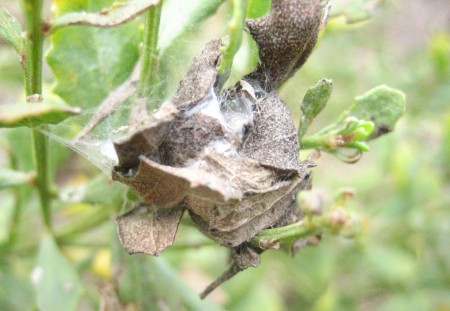
I also liked this shot of a gall from the stem gall moth (Gnorimoschema baccharisella), with what I think is an emergence hole:

Here’s an old G. baccharisella stem gall, dried out with the passage of time, also with an apparent emergence hole:
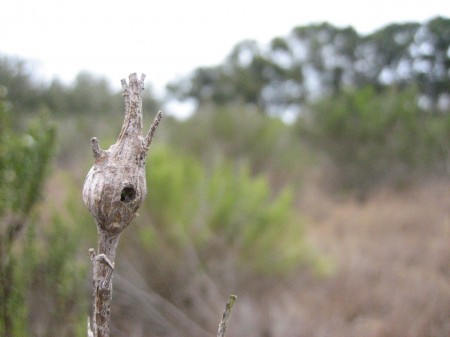
Even though the background is fuzzy, you can recognize the location if you’re familiar with the Bluffs. The tip of the dead stem divides the north-south row of tamarisk (on the left) from the blue-gum eucalyptus of the Artists’ Passage (on the right). That first blue gum is actually the same tree I wrote about previously that blew over in the big wind back in January. It seems to be doing okay in its new, recumbent position.



